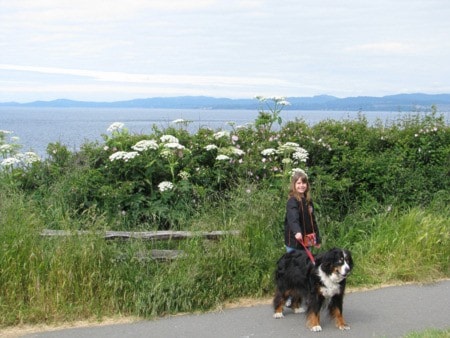Warning! A giant hogweed plant has been found growing in the Comox Valley in a garden on Third Street in Courtenay.
Luckily, the homeowner phoned his sister Jennifer Buck, a local landscaper, to come see the “incredible plant” before he pulled it out.
Her identification of this highly toxic plant prompted a call to the City of Courtenay and a crew from public works removed the plant safely.
I have mentioned giant hogweed in past columns but it bears repeating if only to inform newer immigrants to our Valley of the potential harm associated with this plant.
Heracleum mantegazzianum is a member of the carrot family. An incredibly tall perennial, it can grow to eight feet (2.5 metres) — 15 feet (4.5 m) when in flower.
The flower itself is made up of many small white florets in a large, flat-topped umbel, much like Queen Anne’s Lace, only bigger.
Stout, hollow stems are either reddish-purple or green with dark spots in colour and two to four inches (5-10 cm) in diameter. Dark green, compound leaves are deeply incised and can measure up to five feet (1.5 m) across.
Native to southwest Asia, Heracleum mantegazzianum was introduced as a garden ornamental into North America in 1917. In B.C., it can be found in the Central Kootenay region, Lower Mainland, Fraser Valley, on the Gulf Islands and Vancouver Island from Victoria as far north as Campbell River.
Preferring damp soil conditions and full sun, giant hogweed will tolerate shade and drier aspects. Many roadside ditches, right-of-ways, vacant lots, wetlands and agricultural areas have been infested with this noxious weed.
It does not take long.
Once the plants reach flowering maturity, each one is capable of producing up to 100,000 winged seeds. Distribution can be far-flung. The seeds are also capable of floating for three days before sinking should they land in water. And, they can remain viable in the soil for up to 15 years.
In the Pacific Northwest, Heracleum mantegazzianum sprouts in early spring, either from the roots or from seed. Seedlings are identified from mature plants by their more palmate leaf pattern. Flowering occurs in June with seed formation following in July.
The real danger with giant hogweed lies in its extreme toxicity. The stalks and blister-like pustules on the stems exude a clear watery sap containing glucosides called furanocoumarins.
These toxic organic compounds are photodynamic agents, meaning they operate through light energy by absorbing ultraviolet photons. Certain plants naturally produce furanocoumarins to combat fungus diseases and to ward off insects and animals.
It is this phototoxin ability in the sap that sensitizes the skin to ultraviolet radiation if you should brush against the plant. Symptoms of photosensitization are heat, redness, itchiness, swelling and blistering which can last for many days, weeks, even months.
It depends on the levels of furanocoumarins in these plants, as well as an individual’s DNA makeup that determines photosensitivity.
Phototoxic plants are generally found within four families: Umbellifereae (or Apiaceae), Rutaceae, Moraceae (fig) and Leguminoseae (or Fabaceae). Beware the sap in parsnips, as a friend painfully found out.
If you should get any sap on your skin, immediately wash with soap and cold water. Keep exposed skin out of sun and treat affected area as for a surface burn.
If you get the sap in your eyes, it can cause temporary, sometimes permanent blindness. Immediately flush eyes out with copious amounts of water and see a doctor right away.
Properly outfitted, you can deal with removing giant hogweed yourself when the plant first appears in spring. Dress in waterproof clothing with long sleeves, use safety goggles and heavy rubber gloves. The sap will seep through non-waterproof clothes and regular gardening gloves.
Dig out the plant, going down a minimum of four inches to make sure you are getting the root. Dispose of the plants in heavy-duty garbage bags, heavy enough that the sides will not be pierced by any sharp pieces of stalk. Do not compost them!
For plants that have reached full size, best to call your public works guys. There are still no known biological control agents for giant hogweed.
I must mention the good work the Comox Valley Naturalist Society has undertaken to keep giant hogweed, and other invasive plants, under control.
They mention in their Wetland Restoration Project Report, dated December 2010, the giant hogweed plant removed from the Airpark Walkway in 2009 did not come back. They also noted the removal in 2010 of two new plants in two locations on Dyke Rd and two plants in a garden on Hector Road.
If you know of any giant hogweeds, or need positive identification, please let me know. My phone number is 250-337-8051; e-mail duchessofdirt@telus.net.
Thank you, Jen, for bringing your brother’s toxic plant to our attention. Education is key.
Leslie Cox co-owns Growing Concern Cottage Garden in Black Creek. Her column appears every second Friday.
